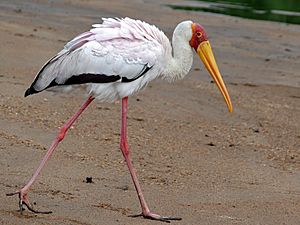Yellow-billed stork facts for kids
The yellow-billed stork (Mycteria ibis) is a large and interesting bird. It is a type of stork found in Africa and Madagascar. These storks live in areas south of the Sahara desert. They belong to the Ciconiidae family, which includes all storks.
What is a Yellow-billed Stork?
The yellow-billed stork is known for its bright yellow bill, which gives it its name. These birds are quite tall, usually standing about 90 to 105 centimeters (35 to 41 inches) high. They have a wingspan of about 150 to 165 centimeters (59 to 65 inches). Adult storks have mostly white feathers with some black feathers on their wings. Their legs are long and reddish-orange.
How Do They Look?
Young yellow-billed storks look a bit different from adults. Their backs are usually grey, while adult storks have white backs. As they grow older, their feathers change to the bright white of the adults. Their beaks are also duller when they are young and become brighter yellow as they mature.
Where Do Yellow-billed Storks Live?
These storks are found across a wide area in Africa. You can see them in many countries south of the Sahara Desert. They also live on the island of Madagascar. They prefer to live near water, such as rivers, lakes, and swamps. This is because their food source is found in these wet areas.
Preferred Habitats
Yellow-billed storks often gather in wetlands, which are areas of land covered by shallow water. These places are perfect for them to find food. They can be seen in national parks and reserves where they are protected. They are also sometimes found in flooded grasslands or even rice paddies.
What Do Yellow-billed Storks Eat?
Yellow-billed storks are carnivores, which means they eat meat. Their main diet consists of fish. They also eat other small water animals. These can include frogs, insects, and small crustaceans.
How Do They Hunt?
These storks have a unique way of hunting. They walk slowly through shallow water, stirring up the bottom with one of their feet. This movement helps to scare out fish and other prey hiding in the mud or plants. When a fish moves, the stork quickly snaps its bill shut to catch it. They often hunt in groups, which can make it easier to find food.
Life Cycle and Reproduction
Yellow-billed storks build large nests, usually in trees near water. They often nest in colonies, meaning many pairs build their nests close to each other. Both parents help to build the nest and take care of the eggs and chicks.
Raising Their Young
A female stork usually lays two to three eggs. The eggs hatch after about 30 days. The young chicks are born without feathers and are completely dependent on their parents. Both parents feed the chicks until they are old enough to fly, which takes about 55 to 60 days. Once they can fly, the young storks start to learn how to hunt for themselves.
Images for kids
-
Immature at Maasai Mara National Reserve
 In Spanish: Tántalo africano para niños
In Spanish: Tántalo africano para niños













